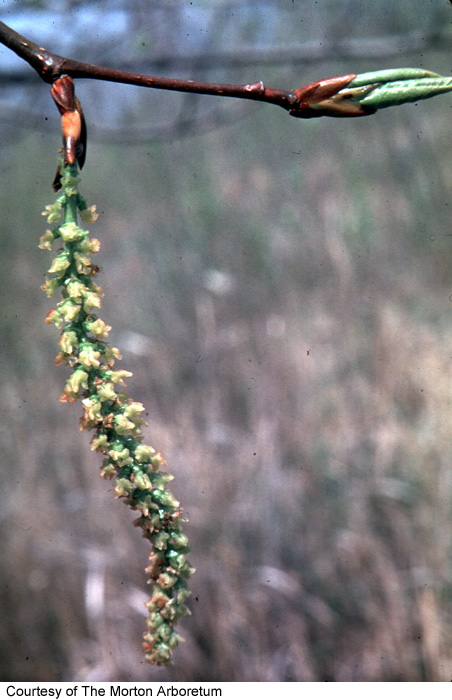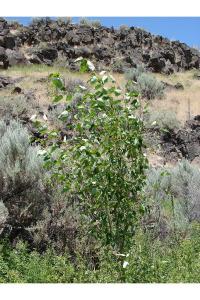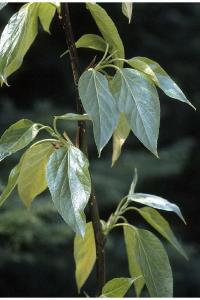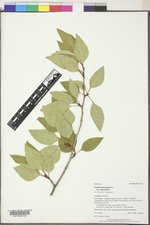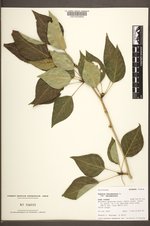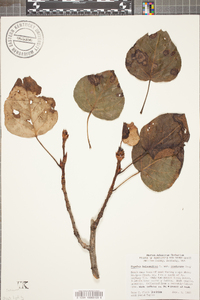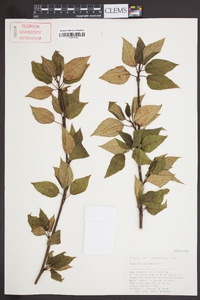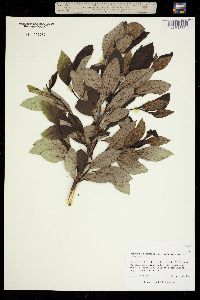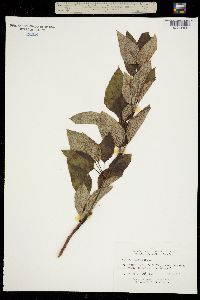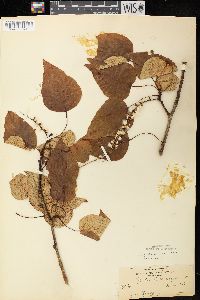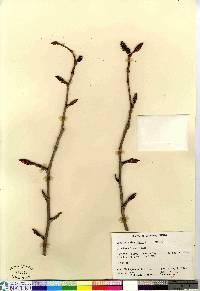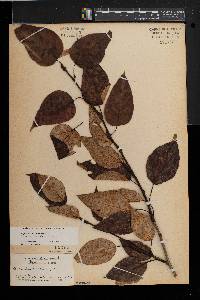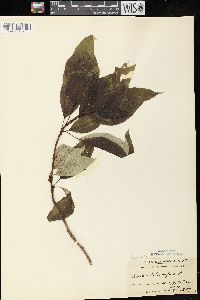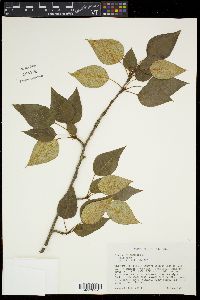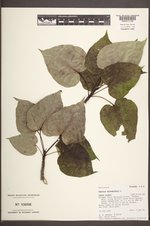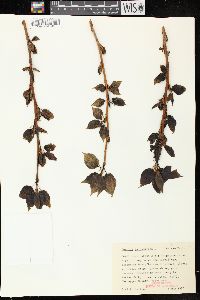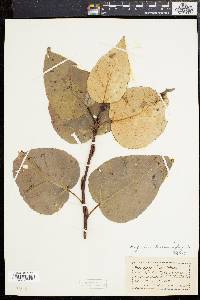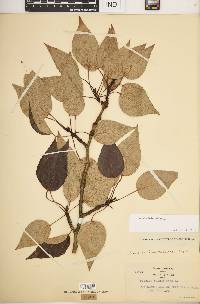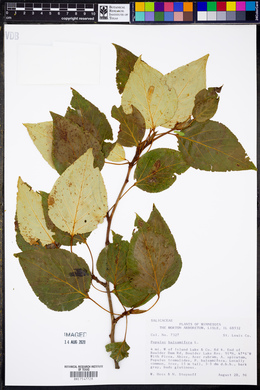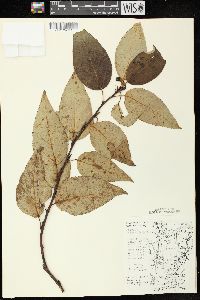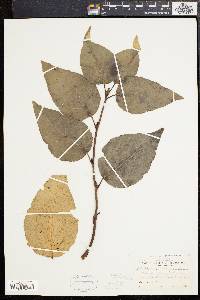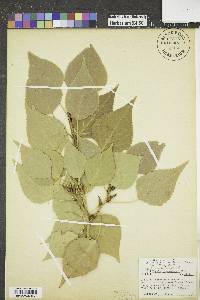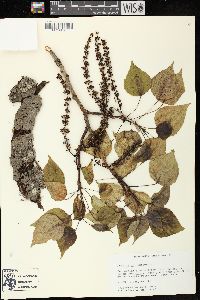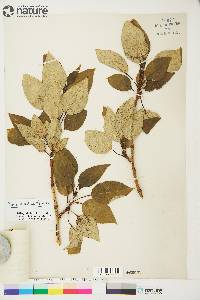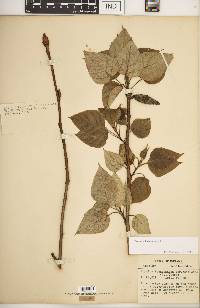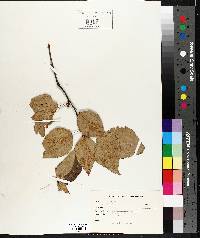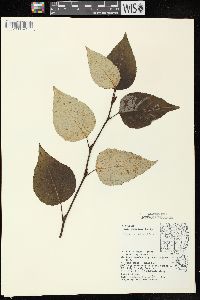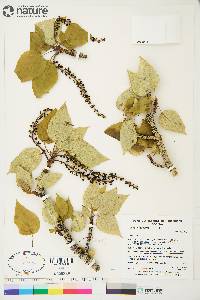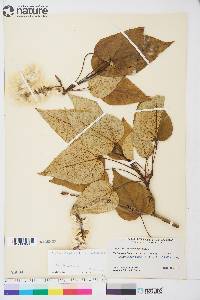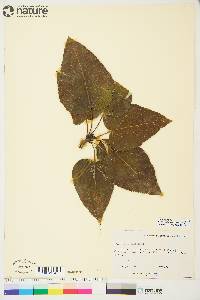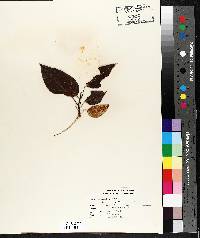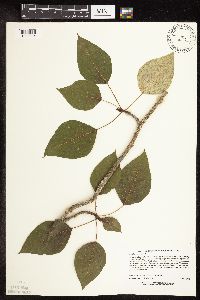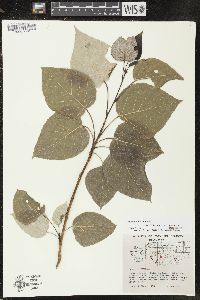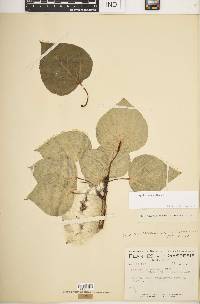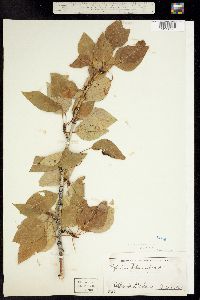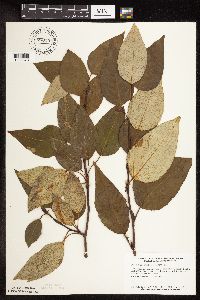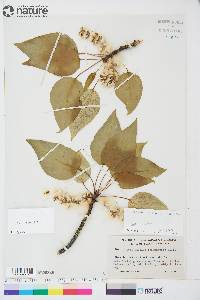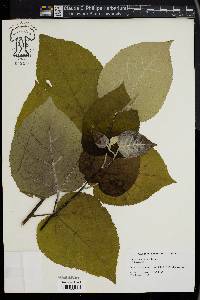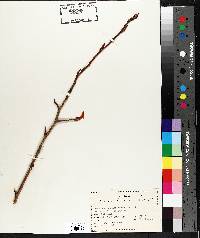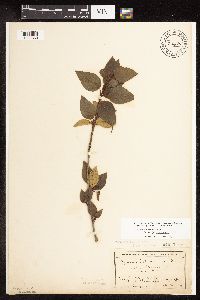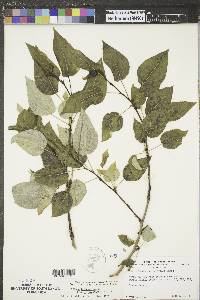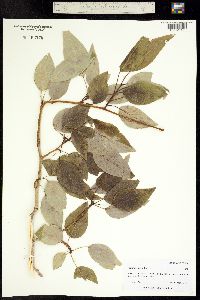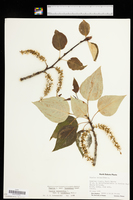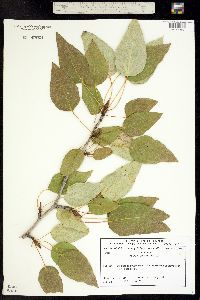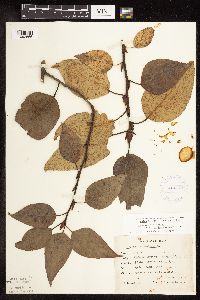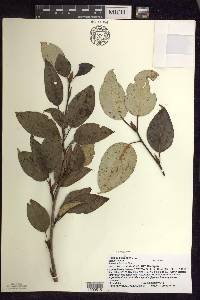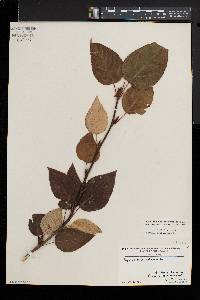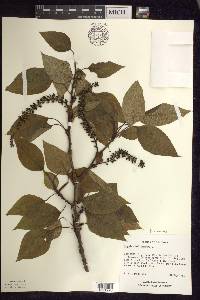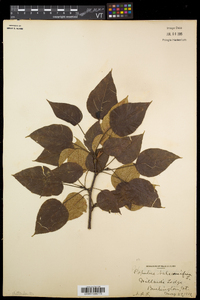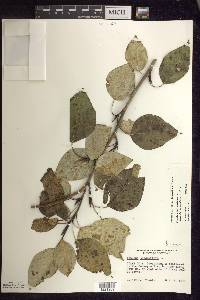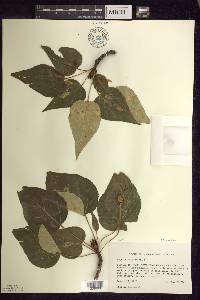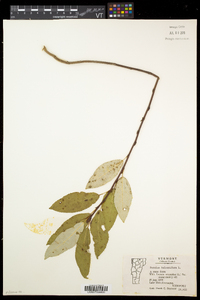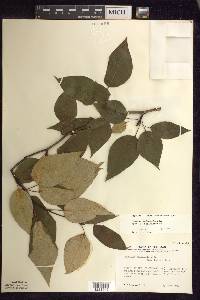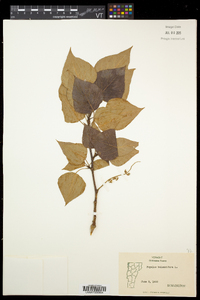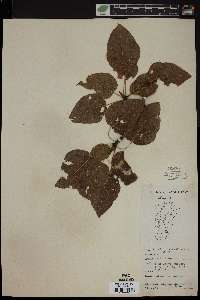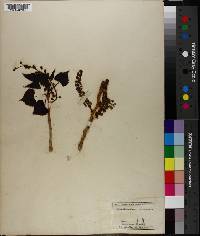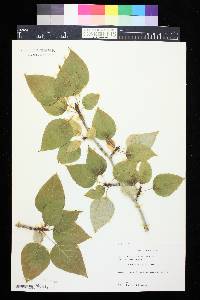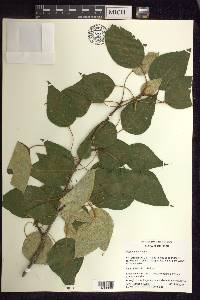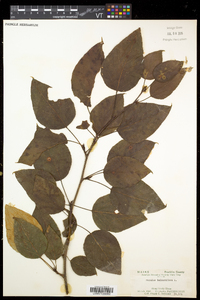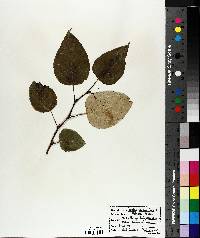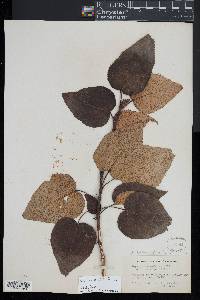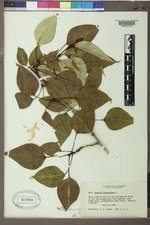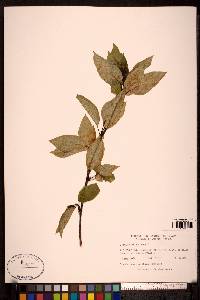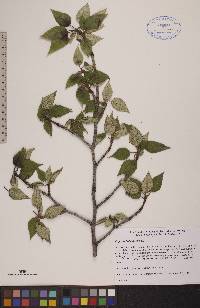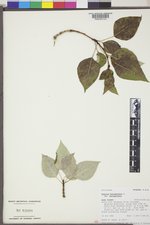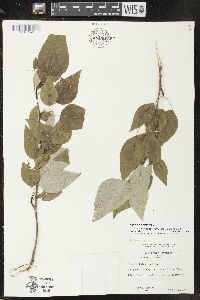
|
|
|
|
Family: Salicaceae
Balsam Poplar
[Populus tacanahaca var. candicans (Aiton) Stout, morePopulus tacanahaca var. lanceolata (Marshall) Farw., Populus tacanahaca var. michauxii (Dode) Farw.] |
Plants to 40 m, 21 dm diam.; weakly heterophyllous. Bark reddish gray, furrowed. Branchlets reddish brown, becoming grayish brown by third year, round, 1.5-3.5(-5) mm diam., coarse, glabrous or glabrate to densely hairy. Winter buds reddish, glabrous, resinous (resin red, abundant, very fragrant, balsamic); terminal buds (8-)12-16(-20) mm; flowering buds clustered distally on branchlets, 15-19 mm. Leaves: petiole cylindrical or distally slightly flattened in plane of blade, (0.2-) 1.5-5 cm, 1/3-1/2 blade length (usually glabrous); blade usually narrowly ovate to ovate, rarely broadly ovate, (2.5-)5-9(-15) × (0.7-)3-5.5(-9) cm, w/l = 1/2-2/3, base rounded to broadly cuneate or subcordate, basilaminar glands 0 or 2(-5), round, margins not translucent, not ciliate, apex obtuse to acute, abaxial surface often with reddish orange resin stains, glaucous, (veins prominent), adaxial dark green, glabrous; preformed blade margins subentire to very finely, evenly crenate-serrate throughout, teeth (9-)20-35(-45) on each side, sinuses 0.1-0.4 mm deep; neoformed blade margins finely crenate-serrate throughout, teeth (20-)30-45 (-60) on each side, sinuses 0.2-0.6 mm deep. Catkins moderately loosely (35-)50-70(-80)-flowered, 7.5-15(-18 in fruit) cm; floral bract apex deeply cut, not ciliate. Pedicels 0.5-2(-3.5 in fruit) mm. Flowers: discs shallowly cup-shaped, not obviously oblique, entire, 2-3(-4) mm diam.; stamens 20-30; anthers truncate; ovary 2-carpelled, ovoid to spherical; stigmas 2-4, platelike, expanded, reflexed. Capsules ovoid, (3-) 5-8 mm, glabrous, 2-valved. Seeds 15-22 per placenta. 2n = 38. Flowering Mar-Jun; fruiting May-Jul. Open, rich, low woods, cool, seasonally wet soils, bog margins in boreal forests, aspen parklands, montane streamsides, rocky slopes, gallery forests within tundra; 0-2900 (-3700) m; St. Pierre and Miquelon; Alta., B.C., Man., N.B., Nfld. and Labr. (Nfld.), N.W.T., N.S., Nunavut, Ont., P.E.I., Que., Sask., Yukon; Alaska, Colo., Conn., Del., Ill., Ind., Iowa, Maine, Mass., Mich., Minn., Mont., N.H., N.Y., N.Dak., Ohio, Pa., S.Dak., Vt., W.Va., Wis., Wyo. Populus balsamifera has been reported in error from Nebraska based on incorrectly localized specimens and from Idaho, Oregon, and Utah based on vegetative specimens of P. trichocarpa or intergrades. The two species can be difficult to separate vegetatively, particularly in their region of overlap and hybridization along the northern Cordilleran axis from southern Alaska to northwestern Wyoming. Their hybrids, named P. ×hastata Dode, have intermediate leaf shapes and also differ from P. balsamifera in having capsules with 2-4 sparsely hairy or glabrous valves (T. C. Brayshaw 1965). Populus balsamifera also hybridizes and intergrades with another native species of sect. Tacamahaca, P. angustifolia, to form P. ×brayshawii B. Boivin where the margins of their ranges overlap (Brayshaw 1965b). Populus ×brayshawii is intermediate in some respects between its parents. It is most similar to P. angustifolia; it differs in longer petioles and darker twigs, characteristics in which it approaches P. balsamifera. Some trees of P. balsamifera from North Dakota (Bottineau and Divide counties) also seem to show an influence of P. angustifolia, although they are far from the present range of the latter species. Populus ×jackii Sargent (synonyms P. ×andrewsii Sargent, P. ×bernardii B. Boivin, P. ×dutillyi Lepage, and P. ×gileadensis Rouleau) is an intersectional hybrid with P. deltoides (sect. Aigeiros) and is moderately common in riparian and other wet habitats throughout the broad range of overlap between these two species (Alberta, Colorado, Illinois, Indiana, Iowa, Manitoba, Massachusetts, Michigan, Minnesota, Montana, Nebraska, New York, North Dakota, Ontario, Quebec, Pennsylvania, Saskatchewan, South Dakota, West Virginia, and Wisconsin) (W. G. Ronald et al. 1973; J. E. Eckenwalder 1984). A pistillate clone that probably arose from this hybrid by segregation or backcrossing (`Balm-of-Gilead´) has been widely cultivated since at least the eighteenth century for its bud resin, used in treating coughs (E. Rouleau 1948). Capsules rarely, if ever, mature and trees do not appear to produce fertile seed, but persist and spread by root sprouts in waste places and at edges of woods. It is cultivated mostly in southeastern Canada and eastern United States to the Great Plains, chiefly in m Medium-sized to large tree 18 - 30 m tall, trunk diameter 30 cm - 0.6 m Leaves: alternate, on 3 - 4 cm long leafstalks, dark green above, whitish green or silvery beneath (often stained brown with resin), 8 - 13 cm long, nearly half as wide, egg-shaped to almost lance-shaped with a rounded base and long-pointed tip, round-toothed, thin, firm, and shiny. Young leaves are fragrant. In autumn the leaves turn yellow to yellowish brown. Flowers: either male or female, borne on separate trees (dioecious) in hairy-bracted catkins. Male catkin long-stalked, reddish, and 8 - 10 cm long. Female catkin long-stalked, loose-flowered, 10 - 13 cm long, and slender. Fruit: a two-valved capsule, borne in 10 - 15 cm long drooping catkins, short-stalked, 6 - 8 mm long, egg-shaped. Seeds light brown with cottony hairs attached. Bark: thin and relatively smooth on young trees, becoming gray, thick, and deeply fissured into broad, flat-topped ridges. Twigs: stout, reddish brown, becoming dark orange then greenish gray. Terminal buds: reddish brown, 1.5 - 2 cm long, egg-shaped, long-pointed, resinous, and fragrant. Form: narrowly pyramidal and open, with upright branches. The trunk is straight and slender. Similar species: The similar Populus heterophylla differs by having long-pointed, hairless, and often resin-stained leaves. Flowering: April, before the leaves Habitat and ecology: Populus balsamifera is the most widespread native tree species in North America, primarily found in the northern and boreal forest regions. It is typically found in moist habitats, including river floodplains, stream and lake shores, swamps, and moist depressions. In the Chicago Region, it has been found in the dune areas around Lake Michigan, along clay slopes of ravines, in weedy fields, and along railroad right-of-ways. It still occurs as a native in the Chicago Region, but very rarely. Occurence in the Chicago region: native Notes: The wood of Populus balsamifera is used for furniture stock, excelsior, boxes, and pulp. Populus species as a whole are subject to many diseases and insect pests, such as canker and tent caterpillars, which often kill the tree or make it unattractive. These risks, in conjunction with a water-hungry root system, have made Populus species less desirable for landscape use. Etymology: Populus is the Latin word for poplar. Balsamifera means balsam-bearing. Author: The Morton Arboretum Tall tree with dark gray furrowed bark and glabrous or hairy twigs; terminal buds glabrous, viscid; petioles ±terete; lvs resinous, ovate to lance-ovate, acute or short-acuminate, finely serrate or subentire, cuneate to rounded or subcordate at base, glabrous, dark green above, white and glaucous (often streaked with orange resin) beneath; scales of the catkins long- ciliate; stamens 20-30; stigmas 2, nearly sessile, broadly dilated; frs ovoid, 2-valved, 5-8 mm, crowded on short pedicels, forming a compact, spike-like raceme; seeds 15-22 per placenta; 2n=38. Wet woods, river-banks, and shores; Lab. to Alas., s. to Conn., n. Pa., n. Ind., n. Io., Nebr., and Colo. (P. tacamahacca) Gleason, Henry A. & Cronquist, Arthur J. 1991. Manual of vascular plants of northeastern United States and adjacent Canada. lxxv + 910 pp. ©The New York Botanical Garden. All rights reserved. Used by permission. From Flora of Indiana (1940) by Charles C. Deam A few colonies of this poplar have been found along Lake Michigan in Lake, Porter, and La Porte Counties, and it has been found in St. Joseph County. The trees I have seen are small ones near the lake front. [Variety candicans, a form with more rounded, pubescent leaves] is found in the eastern part of the range of the species and is found as a small tree along Lake Michigan. The clone, Balm of Gilead, originating from a specimen of this variety, has been freely planted but I do not know of any place where it is spreading. …… Indiana Coefficient of Conservatism: C = 10 Wetland Indicator Status: FACW |

